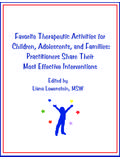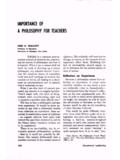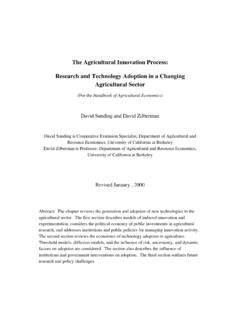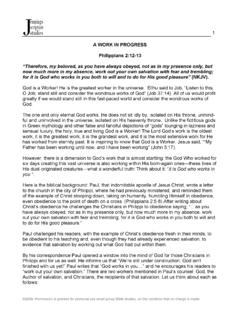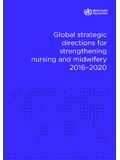Transcription of Reframing the Mind - educationnext.org
1 2004 /EDUCATION NEXT19check the factsbyDANIEL T. WILLINGHAMF rames of Mind: The Theory of Multiple Intelligences (Basic Books, 1983)Multiple Intelligences: The Theory into Practice (Basic Books, 1993)Intelligence Reframed: Multiple Intelligences for the21st Century (Basic Books, 1999)By Howard GardnerChecked by Daniel T. WillinghamWhat would you think ifyour child came homefrom school and reportedthat the language-arts lesson of theday included using twigs and leaves tospell words? The typical parent mightreact with curiosity tinged with sus-picion: Is working with twigs and leavessupposed to help my child learn tospell? Yes, according to Thomas Arm-strong, author ofMultiple Intelligences inthe Classroom,especially ifyour child ishigh in naturalist intelligence one ofeight distinct intelligences that Har-vard University scholar Howard Gard-ner claims to have identified.
2 How-ever, if your child possesses a highdegree of what gardner terms bodily-kinesthetic intelligence, Armstrongsuggests associating movement withspelling. For example, a teacher mighttry to connect sitting with consonantsand standing with is far from alone in plac-ing faith in gardner s theory of mul-tiple intelligences. gardner s ideas havebeen a significant force in education forthe past 20 years significant enoughthat they bear close study. How doesthe scientific community regard thetheory of multiple intelligences, andwhat impact should the theory have oneducation?Central Claims gardner first proposed his theory in1983. Since then, it has undergoneincremental but not fundamentalchange, including the addition of oneintelligence (bringing the total toeight), the rejection of others, and con-sideration of the theory s theory rests on three core claims: gardner says that most psycho-metricians, those who devise andinterpret tests as a way of probingthe nature of intelligence, conceive ofintelligence as unitary.
3 In IntelligenceReframed, gardner s most recentrestatement of his general theory, hewrites, In the ongoing debate amongpsychologists about this issue, thepsychometric majority favors a gen-eral intelligence perspective. This is not an accurate character-ization of the position taken by mostpsychometricians. As will be shown,the vast majority regard intelligencenot as a single unified entity, but as amultifaceted phenomenon with ahierarchical structure. There are multiple, are three parts tothis claim, and it is important toappreciate all three. First, Gardneroffers a new definition ofintelligence,describing it as a biopsychologicalpotential to process information thatcan be activated in a cultural settingto solve problems or create productsthat are of value in a culture. Previ-ous definitions were limited to cog-nition or thought; one was intelli-gent to the extent that one couldsolve problems and adapt effectivelyto one s environment using thinkingskills.
4 gardner self-consciouslybroadens the definition to includeeffective use of the body and think-ing skills relevant to the social also extends the functionality ofintelligence to include the crafting ofuseful products, not just the solvingof problems. Second, gardner claimsto have identified some (but not all)of the several types of intelligence,which I describe below. Third, heclaims that these multiple intelli-gences operate independently of oneanother. The multiple intelligences theory hasapplications to education. gardner hasbeen careful to say that he has pro-posed a scientific theory that shouldnot be mistaken for a prescriptionfor schooling. He makes clear thatthe educational implications of chil-dren s possessing multiple intelli-gences can and should be drawn, buthe believes that many possible cur-ricula and methods could be consis-tent with the theory.
5 The sole gen-eral implication he supports is thatchildren s minds are different, and aneducation system should takeaccount of those differences, a pointPHOTOGRAPH BY CORBISR eframing the MindHoward gardner became a hero among educators simply by redefining talents as intelligences developed in diverse ways by hismany Intelligence or Many?Let s evaluate each of gardner s claimsin turn, beginning with how psycho-metricians view intelligence. In theearly 20th century, many psychome-tricians did in fact think of intelligenceas a unitary trait, just as gardner nowclaims. The thinking at that time wasarticulated by Charles Spearman, whosuggested that a single factor (he calledit g,for general) underlay all intelligentbehavior. If you had a lot ofg,you weresmart; if you didn t, you weren t. How-ever, by the 1930s some researchers(notably Louis L. Thurstone) werealready arguing for a multifaceted viewof intelligence.
6 One might be intelligentin the use of words, for example, butunintelligent mathematically. From the1950s on, many psychometricians pro-posed hierarchical models, which maybe thought of as a mixture of the sin-gle-factor and multiple-factor for a few holdouts, most psy-chologists now favor the can one use data from tests ofcognitive ability to evaluate the num-ber of intelligences? A straightforwardapproach entails administering a num-ber of separate tests thought to rely ondifferent hypothesized tests 1 and 2 are differenttests of verbal ability (for example,vocabulary and spelling), and tests 3and 4 are different tests of mathemat-ical ability. If there is one intelligence,g,then gshould support performanceon all four tests, as shown in diagramA of Figure 1 (this page). A high scoreon test 1 would indicate that the test-taker is high in g,and he or she shouldperform well on all of the other , however, that there aretwo intelligences one verbal and onemathematical, as shown in diagram Bof Figure 1.
7 In that case, a high scoreon test 1 would predict a high score ontest 2, but would tell us nothing aboutthe individual s performance on themath tests, 3 and 4. Performance onthose tests would depend on mathe-matical intelligence, which is separateand independent of verbal data support neither of theseviews. To continue with our hypo-thetical example, the data show that allof the test scores, 1 through 4, aresomewhat related to one another,which is consistent with the scores from tests of mathability are more related to one anotherthan they are to verbal scores; the samegoes for verbal scores. A hierarchicalmodel, shown in diagram C of Figure1, fits this pattern. In this model,ginfluences both mathematical and ver-bal cognitive processes, so performanceon math and verbal tests will be some-what related. But mathematical com-petence is supported not just by g,butby the efficacy of a mathematical intel-ligence that is separate and indepen-dent of a verbal intelligence.
8 That swhy math scores are more related toeach other than they are to verbalscores. It also explains how it is possi-ble for someone to be quite good inmath, but just mediocre verbally. Thislogic applies not only to the restrictedexample used here (math and verbal)but also to a broad spectrum of tests ofintellectual hierarchical view of intelli-gence received a strong boost from alandmark review of the published datacollected over the course of 60 yearsfrom some 130,000 people around theworld. That massive review, performedby the late University of North Car-olina scholar John Carroll, concludedthat the hierarchical view best fits thedata. Researchers still debate the exactorganization of the hierarchy, but thereis a general consensus around the 20 EDUCATION NEXT /SUMMER view of intelligence. ThusGardner s first claim that most psy-chometricians believe that intelligenceis unitary is Are the Intelligences?
9 gardner s second claim is that indi-viduals possess at least eight indepen-dent types of intelligence. The follow-ing list includes a definition of eachalong with examples gardner has pro-vided of professions that draw heavilyon that particular intelligence. Linguistic:facility with verbalmaterials (writer, attorney). Logico-mathematical:the ability touse logical methods and to solvemathematical problems (mathemati-cian, scientist). Spatial:the ability to use andmanipulate space (sculptor,architect). Musical:the ability to create, per-form, and appreciate music (per-former, composer). Bodily-kinesthetic:the ability to useone s body (athlete, dancer). Interpersonal:the ability to under-stand others needs,intentions,andmotivations (salesperson, politician). Intrapersonal:the ability to under-stand one s own motivations andemotions (novelist, therapist withself-insight).
10 Naturalist:the ability to recognize,identify, and classify flora and faunaor other classes of objects (natural-ist, cook). gardner claims that everyone hasall eight intelligences to some degree,but each individual has his or her ownpattern of stronger and weaker intel-ligences. gardner also argues thatmost tasks require more than oneintelligence working together. Forexample, the conductor of a symphonyobviously uses musical intelligence,but also must use interpersonal intel-ligence as a group leader and bodily-kinesthetic intelligence to move in away that is informative to the orches-tra. The claim of separate and inde-pendent intelligences is, of course,central to gardner s theory. How dowe know that these intelligences areindependent? It is important to bear in mind thatthe hierarchical model described inthe previous section is not a theory, buta pattern of is a description ofhow test scores are correlated.

